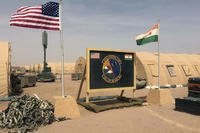It looks like the Army's high-priority Ground Combat Vehicle program may soon have more competition for securing shrinking defense dollars. U.S. Army Aviation officials made another pitch for bigger, faster, more advanced helicopters for the future at AUSA's Aviation Symposium in Washington, D.C.
It's been nearly a decade since the Army killed cancelled the Comanche helicopter, a high-tech, reconnaissance aircraft that wasted two decades and $7 billion. Since then the Army has reprogrammed about $36 billion into upgrades of existing Black Hawk, Chinook and Apache airframes.
"We are just now getting to the end of what we gained for those decisions with Comanche," said Lt. Gen. James Barklay, Army G8. "Now we have got to start focusing on what the aviation portfolio has in the future. As we look at the next 10 years, we've got to determine how we are going to balance all these programs and get at the needs and requirements" of Army aviation
Aviation officials agree that the Army must develop "future vertical lift" options that can fly faster, father and carry more payload than anything in the current inventory, said Maj. Gen. Kevin Mangum, commanding general of the Army Aviation Center of Excellence. Aviation officials maintain that future aircraft must be able to carry a nine-man squad. They must be able to haul the Army and Marine Corps M777, a 9,000 pound 155mm howitzer. They will also need greater range -- the ability to self deploy from the United States to the Philippines to support new missions in the Pacific region.
In the near term, Army aviation officials continue to hold onto the need for an armed reconnaissance helicopter.
"Our most urgent capability gap right now is manned, armed reconnaissance," Mangum said. "We do have a requirement and we are going to fill that requirement and we are going to figure how we are going to do so soon."
This will surely be a difficult challenge for the Army, since it continues to pursue other top procurement priorities such as the GCV, the Network and the Joint Light Tactical Vehicle programs.
Army aviation officials have no illusions that future modernization goals will be an uphill struggle with the fiscal uncertainties the service faces with the pending decision on sequestration cuts across the Pentagon.
The service has been successful in finding cost savings through multi-year contracts, said Lt. Gen. William Phillips, military deputy/director of the Army Acquisition Corps.
The first multi-year contract for CH-47F Chinooks saved $449 million between fiscal 2008 and fiscal 2012, Phillips said. The service could avoid $810 million with a pending fiscal 2013-2017 contract, a deal the has been delayed because of the Continuing Resolution on last year's defense budget, Phillips maintains.
In addition, the Army saved $1.8 billion with the award of a fiscal 2012-2016 contract for UH-60M Black Hawks, Phillips said.
"When you can come to the table and have solutions like that that provide the Army with an incredible capability and you can go to the leaders in Congress and OSD and show them the dollars you are saving by going to a multi-year solution, that's a win-win for everyone."








